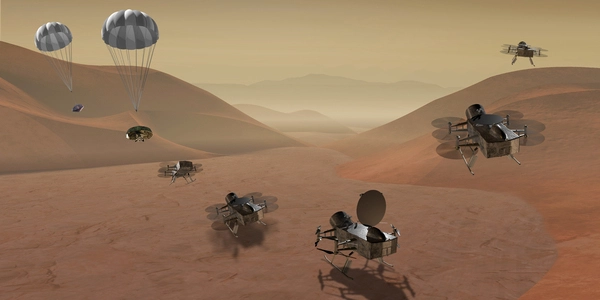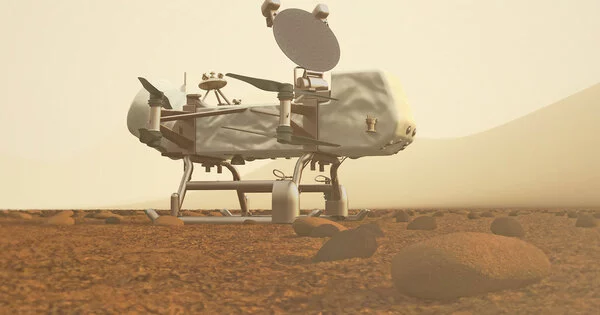According to a new analysis of radar imagery from the Cassini spacecraft, NASA’s Dragonfly mission to Saturn’s largest moon will land on dunes and shattered, icy bedrock. Dragonfly, which will be launched in 2027, is a rotorcraft that will arrive in 2034 and explore Titan from the air. According to NASA, Dragonfly’s range will be far greater than that of a wheeled rover, with each half-hour flight covering approximately 10 miles (16 kilometers). It will explore an area hundreds of miles or kilometers across over the course of its two-year mission.
However, before taking to the skies on its own, Dragonfly must first arrive on Titan via parachute, soft-landing on frozen terrain obscured from view by the dense hydrocarbon smog that fills the moon’s atmosphere.
The Dragonfly will land in the Shangri-La dune field, near the Selk crater, which is 50 miles (80 kilometers) wide. This region was imaged by NASA’s Cassini spacecraft during its mission to Saturn between 2004 and 2017, and a team of scientists led by planetary scientist Léa Bonnefoy of Cornell University has taken a fresh look at that data to produce the most accurate assessment of Dragonfly’s proposed landing site to date.
Dragonfly will land in an equatorial, dry region of Titan. It rains liquid methane sometimes, but it is more like a desert on Earth where you have dunes, some little mountains, and an impact crater.
Léa Bonnefoy
“Dragonfly … is going to a scientifically remarkable area,” Bonnefoy said in a statement. “Dragonfly will land in an equatorial, dry region of Titan. It rains liquid methane sometimes, but it is more like a desert on Earth where you have dunes, some little mountains and an impact crater.”
Selk is an interesting location. Estimated to be geologically young, perhaps a couple hundred million years old, the impact that carved it out would have melted the local ice, prompting interactions between the fresh liquid water and organic molecules present in the hydrocarbon soup on Titan’s surface. Astrobiologists are particularly interested in the prebiotic chemistry — chemistry involving carbon-rich molecules but not mediated by living things — that would have resulted.
Yet Cassini’s radar images of the area are limited, with the resolution at best being 1,000 feet (300 meters) per pixel. “There are probably a lot of small rivers and landscapes that we couldn’t see,” Bonnefoy said.

Scientists know that such rivers do exist on Titan, thanks to the European Space Agency’s Huygens lander, which piggybacked on board Cassini before parachuting down to the surface of Titan in January 2005. These rivers, however, are not full of liquid water — the temperature of minus 290 degrees Fahrenheit (minus 179 degrees Celsius) is far too cold for that. Instead, liquid methane and ethane rain from the frigid sky and wash off the water-ice bedrock and into river tributaries that feed large lakes.
What Cassini’s imagery did provide, however, is multiple viewing angles. Each time it flew past Titan — it enjoyed 127 close approaches of the moon during its mission — it viewed landmarks in the region of Dragonfly’s landing site from different angles, ranging from inclinations of 5 degrees to 72 degrees.
Bonnefoy’s team was able to determine the topography of the region within the limits of the image resolution by analyzing how the terrain produced different-shaped shadows based on the viewing angle, finding no major show-stopping obstacles that Dragonfly would need to avoid.
The scientists also calculated the height of the Selk crater rim, which ranged from less than 650 feet (200 m) in some areas to 2,000 feet (600 m), which is higher than expected, indicating a less eroded crater rim.





